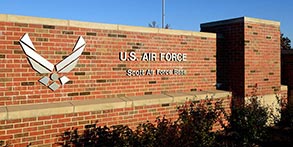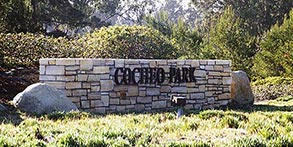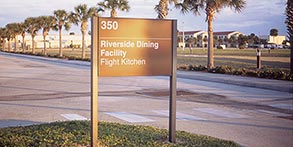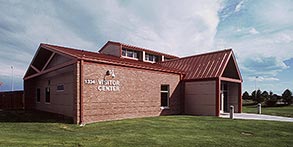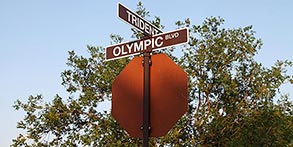- Provide signs with the lowest overall life cycle costs considering initial cost, ongoing maintenance and lifespan while meeting quality standards.
- Follow Installation Facilities Standards (IFS) for material and color specifications appropriate for the local climate to withstand weathering processes.
- Reduce the number of signs to the minimum required for directions, identification, and customer service.
- Use clear concise terms for content consistent with IFS.
- Install freestanding building identification signs with an appropriate quality for the Facility Group following IFS and consistent with UFC classifications: Primary, Secondary or Tertiary.
- Only one identification sign is permitted at each building entrance and it must generally maintain continuity with the facility’s architecture; glass entrances may have appropriately sized vinyl lettering on the glass following IFS.
- Provide building numbers where required by IFS.
- Reserved parking should be kept to a minimum to reduce number of signs and sign maintenance; the use of freestanding and building-mounted signs is discouraged. Comply with UFC and IFS requirements.
- Address both pedestrian and vehicular traffic in directional / wayfinding signs.
- Monument signs are generally limited to Group 1 facilities; follow IFS for use and location.
- Comply with IFS for all temporary or other specialty signs.
- Refer to UFC 3-120-01 for prohibited signs, which include those with animated, blinking, chasing, flashing, or moving effects.
Installations are required to establish and maintain exterior sign standards under Installation Facilities Standards (IFS). Provide visual and functional consistency, maximize durability and minimize maintenance requirements while ensuring a quality professional appearance. Limit the number of signs to the absolute minimum to lower costs and reduce visual clutter. Coordinate historic signs through the state historic preservation office (SHPO). Judiciously replace non-conforming signs to meet current standards.
Sustainability
Coordinate design and selection of materials to ensure components comply with applicable policies. Use environmentally responsible materials, finishes and coatings for sign elements.
Resilience
Provide engineered mounting designs, fabrication and related construction to minimize damage and maintenance associated with the events from documented risks. In areas at risk to high winds ensure post-mounted signs are adequately secured at grade and affixed to posts to avoid becoming an airborne hazard.
UFC 3-120-01 Design: Sign Standards https://www.wbdg.org/dod/ufc/ufc-3-120-01
Manual on Uniform Traffic Control Devices for Streets and Highways http://www.wbdg.org/FFC/FHWA/mutcd.pdf
